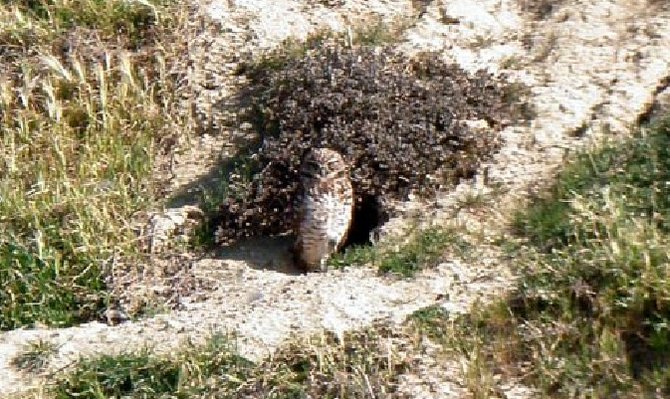 Facebook
Facebook
 X
X
 Instagram
Instagram
 TikTok
TikTok
 Youtube
Youtube

Visitors of Torrey Pines State Natural Reserve are being greeted by a burrowing owl — the first one to be seen in the reserve for decades.
For the past month or so, at the base of a bluff within 20 yards of the park road, the owl has been standing at the entrance to its burrow.
Every day, 1000 to 3000 visitors walk, bike, or drive up the road for exercise or to visit the reserve for its incredible views and natural habitat. The owl seems to be unperturbed and calmly stands in front of its home, checking out all the action.
State biologists are uncertain whether the owl is a male displaying his fine oceanfront abode with an ocean view (in hopes of attracting a mate) or whether the owl is a female protecting a clutch of eggs.
Burrowing owls live in small caves usually made by squirrels or other rodents. If no burrows are available, they will make their own. The owls can live up to nine years in the wild. Although active during the day, they usually hunt at dusk or nighttime. Their diet consists of large insects and small rodents. The owls’ nesting season begins in late March or April. Although not an endangered species, the burrowing owl is a species of special concern, mostly due to habitat loss.
I don’t think anyone has named the owl yet, but she or he is definitely a sight to see. As with all plants, insects, and animals in the reserve, the owl is protected by law. Please look without disturbing our new resident.


Visitors of Torrey Pines State Natural Reserve are being greeted by a burrowing owl — the first one to be seen in the reserve for decades.
For the past month or so, at the base of a bluff within 20 yards of the park road, the owl has been standing at the entrance to its burrow.
Every day, 1000 to 3000 visitors walk, bike, or drive up the road for exercise or to visit the reserve for its incredible views and natural habitat. The owl seems to be unperturbed and calmly stands in front of its home, checking out all the action.
State biologists are uncertain whether the owl is a male displaying his fine oceanfront abode with an ocean view (in hopes of attracting a mate) or whether the owl is a female protecting a clutch of eggs.
Burrowing owls live in small caves usually made by squirrels or other rodents. If no burrows are available, they will make their own. The owls can live up to nine years in the wild. Although active during the day, they usually hunt at dusk or nighttime. Their diet consists of large insects and small rodents. The owls’ nesting season begins in late March or April. Although not an endangered species, the burrowing owl is a species of special concern, mostly due to habitat loss.
I don’t think anyone has named the owl yet, but she or he is definitely a sight to see. As with all plants, insects, and animals in the reserve, the owl is protected by law. Please look without disturbing our new resident.
Comments